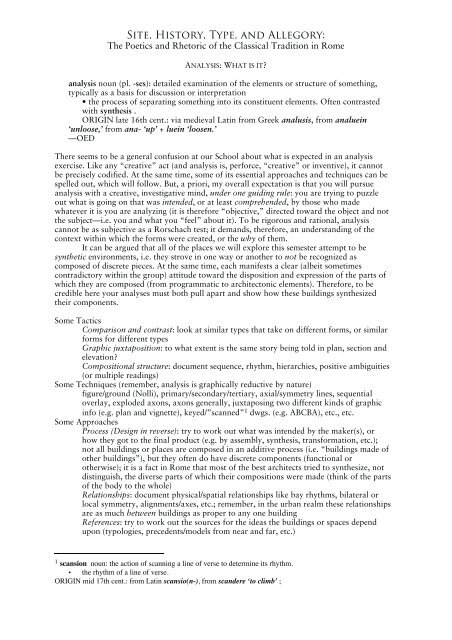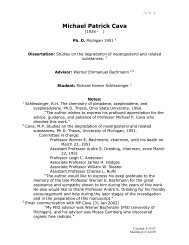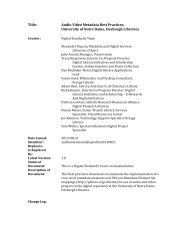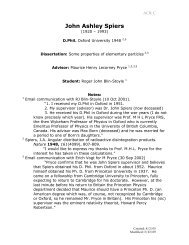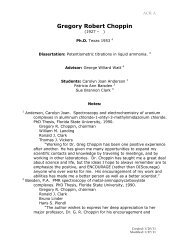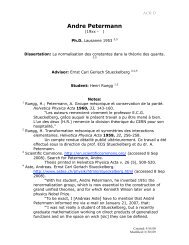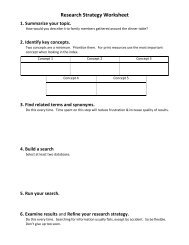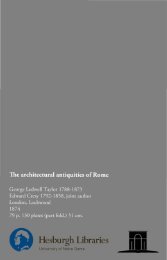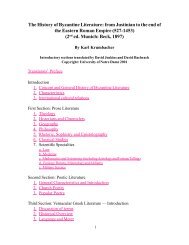ARCH 84312
ARCH 84312
ARCH 84312
You also want an ePaper? Increase the reach of your titles
YUMPU automatically turns print PDFs into web optimized ePapers that Google loves.
Site, History, Type, and Allegory:<br />
The Poetics and Rhetoric of the Classical Tradition in Rome<br />
ANALYSIS: WHAT IS IT<br />
analysis noun (pl. -ses): detailed examination of the elements or structure of something,<br />
typically as a basis for discussion or interpretation<br />
• the process of separating something into its constituent elements. Often contrasted<br />
with synthesis .<br />
ORIGIN late 16th cent.: via medieval Latin from Greek analusis, from analuein<br />
‘unloose,’ from ana- ‘up’ + luein ‘loosen.’<br />
—OED<br />
There seems to be a general confusion at our School about what is expected in an analysis<br />
exercise. Like any “creative” act (and analysis is, perforce, “creative” or inventive), it cannot<br />
be precisely codified. At the same time, some of its essential approaches and techniques can be<br />
spelled out, which will follow. But, a priori, my overall expectation is that you will pursue<br />
analysis with a creative, investigative mind, under one guiding rule: you are trying to puzzle<br />
out what is going on that was intended, or at least comprehended, by those who made<br />
whatever it is you are analyzing (it is therefore “objective,” directed toward the object and not<br />
the subject—i.e. you and what you “feel” about it). To be rigorous and rational, analysis<br />
cannot be as subjective as a Rorschach test; it demands, therefore, an understanding of the<br />
context within which the forms were created, or the why of them.<br />
It can be argued that all of the places we will explore this semester attempt to be<br />
synthetic environments, i.e. they strove in one way or another to not be recognized as<br />
composed of discrete pieces. At the same time, each manifests a clear (albeit sometimes<br />
contradictory within the group) attitude toward the disposition and expression of the parts of<br />
which they are composed (from programmatic to architectonic elements). Therefore, to be<br />
credible here your analyses must both pull apart and show how these buildings synthesized<br />
their components.<br />
Some Tactics<br />
Comparison and contrast: look at similar types that take on different forms, or similar<br />
forms for different types<br />
Graphic juxtaposition: to what extent is the same story being told in plan, section and<br />
elevation<br />
Compositional structure: document sequence, rhythm, hierarchies, positive ambiguities<br />
(or multiple readings)<br />
Some Techniques (remember, analysis is graphically reductive by nature)<br />
figure/ground (Nolli), primary/secondary/tertiary, axial/symmetry lines, sequential<br />
overlay, exploded axons, axons generally, juxtaposing two different kinds of graphic<br />
info (e.g. plan and vignette), keyed/”scanned” 1 dwgs. (e.g. ABCBA), etc., etc.<br />
Some Approaches<br />
Process (Design in reverse): try to work out what was intended by the maker(s), or<br />
how they got to the final product (e.g. by assembly, synthesis, transformation, etc.);<br />
not all buildings or places are composed in an additive process (i.e. “buildings made of<br />
other buildings”), but they often do have discrete components (functional or<br />
otherwise); it is a fact in Rome that most of the best architects tried to synthesize, not<br />
distinguish, the diverse parts of which their compositions were made (think of the parts<br />
of the body to the whole)<br />
Relationships: document physical/spatial relationships like bay rhythms, bilateral or<br />
local symmetry, alignments/axes, etc.; remember, in the urban realm these relationships<br />
are as much between buildings as proper to any one building<br />
References: try to work out the sources for the ideas the buildings or spaces depend<br />
upon (typologies, precedents/models from near and far, etc.)<br />
1 scansion noun: the action of scanning a line of verse to determine its rhythm.<br />
• the rhythm of a line of verse.<br />
ORIGIN mid 17th cent.: from Latin scansio(n-), from scandere ‘to climb’ ;


